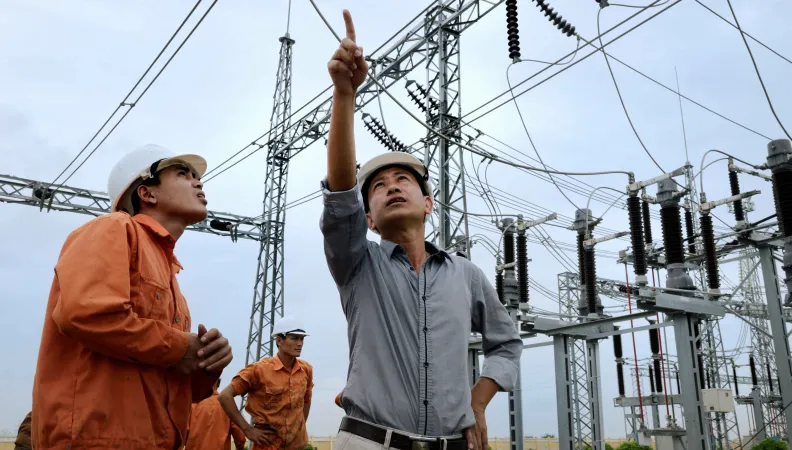Share the page
ESTEEM – Exposure to Structural Transition in an Ecological-Economic Model

-
Project start date
-
2021Status
Ongoing
-
AFD financing amount
-
39 500
-
Country and region
-
Partners
-
Ministry of Natural Resources and Environment (Viet Nam), Ministry of Economic Development and Poverty Reduction (Uzbekistan)
-
Research program
How can we measure the macroeconomic risks that developing countries may encounter during their low-carbon transition? Developed by AFD, the ESTEEM model (Exposure to Structural Transition in an Ecological-Economic Model) identifies the transition risks to which the economies of developing countries are exposed, which makes it possible to anticipate them and to define a transition trajectory adapted to the situation of each country.
Context
The ecological transition is a unique type of structural change: green industries grow while greenhouse gas-intensive and non-green industries decline. This complex process affects the productive, trade and financial structure of national economies, which can generate transition risks.
These risks arise from the dependence of economies on high greenhouse gas emitting industries, which constrains their low-carbon transition:
- External risk: if a country depends on greenhouse gas-intensive industries as a source of foreign exchange, the transition will affect its balance of payments and the country's ability to import goods and services (including the machinery and inputs needed for the transition);
- Fiscal risk: if a country relies on emission-intensive industries as a source of tax revenue, the transition will reduce its budgetary resources, which are needed for public investments relevant to the transition (green infrastructure, social spending...);
- Socio-economic risk: if a country relies on emission-intensive industries as a source of employment, the transition will lead to the destruction of jobs in certain sectors, making targeted measures necessary (social protection, training, etc.).
However, not all countries are equal in the face of the ecological transition: they are affected differently by these changes, depending on the structure of their economy and their trade relations with other economies.
The ESTEEM model has been developed to identify and better understand these risks, so as to be able to define the most appropriate trajectory for each country.
Objectives
The ESTEEM macroeconomic model is a tool developed by AFD to understand countries' transition trajectories, in order to:
- Assess the extent to which their economy is exposed to risks of imbalances in the context of a green transition, by identifying the main macroeconomic constraints that may emerge and how they can be addressed to ensure an adequate transition path;
- Take into account the ecological and environmental specificities of countries, as they are more or less exposed to transition risks depending on the structure of their economy.
Find out more
Method
The research paper "Developing countries' macroeconomic exposure to the low-carbon transition" presents the methodology for assessing countries' exposure to external, fiscal and socio-economic risks. Based on their capacity to adapt their productive structure, it analyses countries' vulnerabilities and risks in these three dimensions. Using an environmental input-output table for 189 countries, it identifies carbon-intensive industries and then estimates each country's direct and indirect dependence on these industries.
Read the research paper
Results
Besides the above research paper, which provides a comprehensive analysis, other studies have been developed. The paper "Impacts of CBAM on EU trade partners: consequences for developing countries", for example, uses the ESTEEM model to analyse the impact of the border carbon adjustment mechanism (CBAM) on the European Union's (EU) trade partners. While most analyses of CBAM have focused on the consequences for EU economies, this research paper focuses on developing and emerging economies.
In addition, AFD is conducting ESTEEM projects in Uzbekistan and Vietnam, in which the ESTEEM model is used to provide the authorities of these two countries with an analysis of the macroeconomic impacts of their low-carbon transition.
Finally, based on the original ESTEEM project, other studies are being developed:
- ESTEEM-Biodiv seeks to understand the risks linked to ecological dimensions other than dependence on carbon-intensive industries (water stress, excessive land use, pollution, etc.);
- ESTEEM-Dynamic, which started in 2022, seeks to understand how the systemic impacts of a transition vary according to the trajectory or scenario selected. This new model, which is dynamic, does not take economic structures as given: by allowing certain variables to be modified, it makes it possible to assess which are the most appropriate paths to follow in order to reduce the risks of transition and ensure the effectiveness of a transition.
Research findings
The studies show that, depending on the structure of their economy, their budgetary leeway and the robustness of their social protection system, countries are more or less exposed to the risks and vulnerabilities generated by a transition to a low-carbon economy. The ESTEEM model, by making it possible to identify these risks, helps to anticipate them in order to promote the success of the transition.
The interest of the national applications of ESTEEM – currently in Uzbekistan and Vietnam – is to provide an analysis taking into account the specificities of each country:
- Uzbekistan: although Uzbekistan does not rely much on declining industries, the Uzbek economy is a high emitter of greenhouse gases in key transition sectors, such as electricity and construction. This means that decoupling trajectories requires productive and technological capacity building actions to ensure an adequate transition trajectory, leading to job creation and avoiding fiscal and external imbalances.
- Vietnam: the analysis shows that Vietnam is a highly exposed economy at socio-economic level, particularly because high-paying jobs are located in declining industries. Furthermore, the analysis of the different climate scenarios shows that the economy is very exposed because the country's agriculture will be strongly impacted. Nevertheless, Vietnam is also a very dynamic economy with a strong capacity to migrate to green products, which can contribute to the success of the transition.
Find out more:
- Developing countries' macroeconomic exposure to the low-carbon transition (AFD Research Papers, October 2021)
- Low-carbon transition: What macroeconomic vulnerabilities for developing countries? (Research Conversation webinar, December 2021)
- Low-carbon transition in Latin America: what are the risks and the main constraints? (Development Matters, OECD blog, June 2022)
- Impacts of CBAM on EU trade partners: consequences for developing countries (AFD Research Papers, March 2022)
Contact
-
Guilherme MAGACHO
Economist - Modeller
